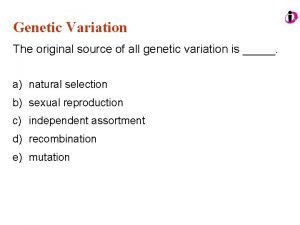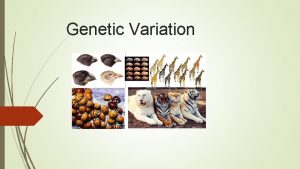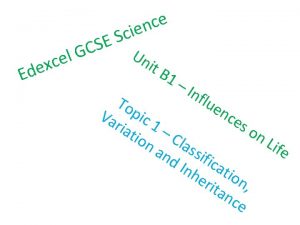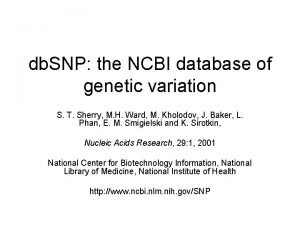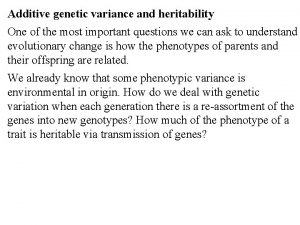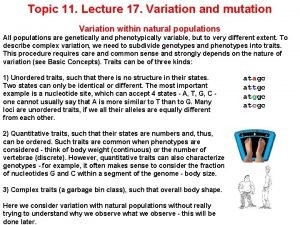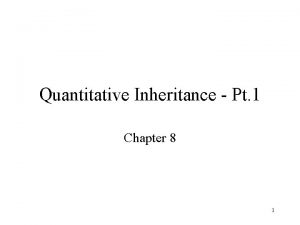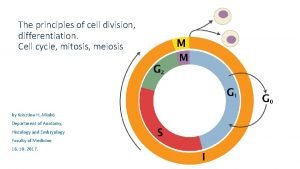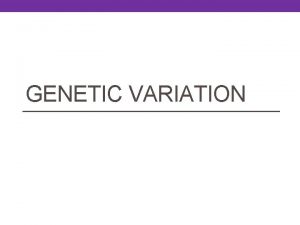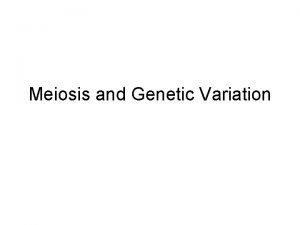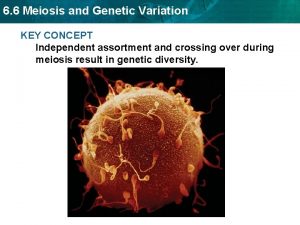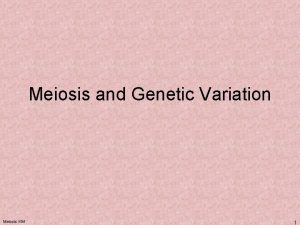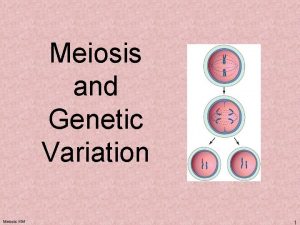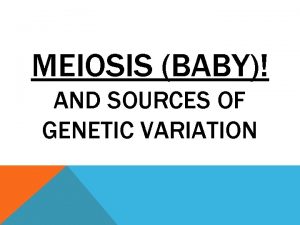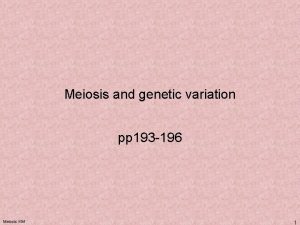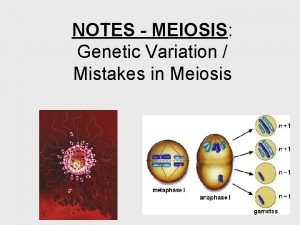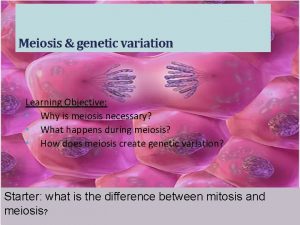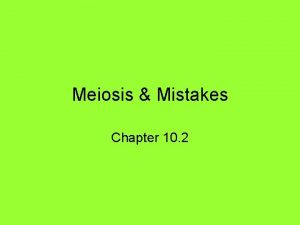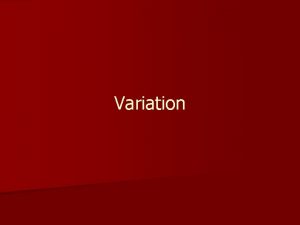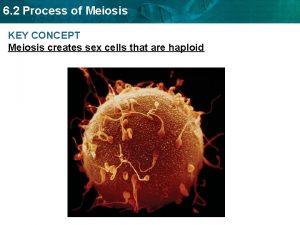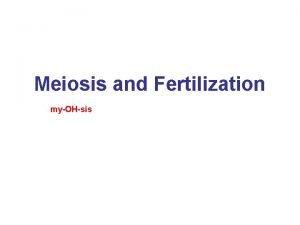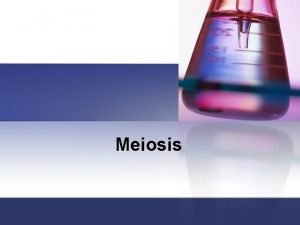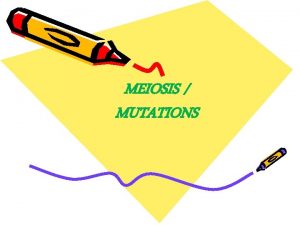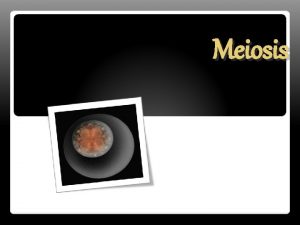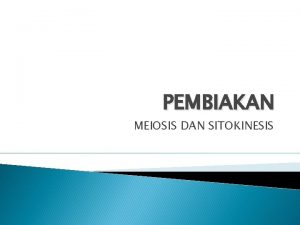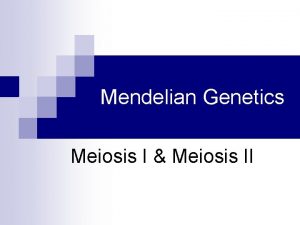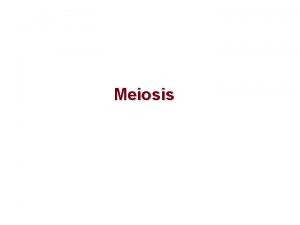6 6 Meiosis and Genetic Variation KEY CONCEPT
























- Slides: 24

6. 6 Meiosis and Genetic Variation KEY CONCEPT Independent assortment and crossing over during meiosis result in genetic diversity.

6. 6 Meiosis and Genetic Variation Sexual reproduction creates unique combinations of genes. • Sexual reproduction creates unique combination of genes. – independent assortment of chromosomes in meiosis – random fertilization of gametes • Unique phenotypes may give a reproductive advantage to some organisms.

6. 6 Meiosis and Genetic Variation Crossing over during meiosis increases genetic diversity. • Crossing over is the exchange of chromosome segments between homologous chromosomes. – occurs during prophase I of meiosis I – results in new combinations of genes

6. 6 Meiosis and Genetic Variation • Chromosomes contain many genes. – The farther apart two genes are located on a chromosome, the more likely they are to be separated by crossing over. – Genes located close together on a chromosome tend to be inherited together, which is called genetic linkage. • Genetic linkage allows the distance between two genes to be calculated.

8. 3 DNA Replication KEY CONCEPT DNA replication copies the genetic information of a cell.

8. 3 DNA Replication copies the genetic information. • A single strand of DNA serves as a template for a new strand. • The rules of base pairing direct replication. • DNA is replicated during the S (synthesis) stage of the cell cycle. • Each body cell gets a complete set of identical DNA.

8. 3 DNA Replication Proteins carry out the process of replication. • DNA serves only as a template. • Enzymes and other proteins do the actual work of replication. – Enzymes unzip the double helix. – Free-floating nucleotides form hydrogen bonds with the template strand. nucleotide The DNA molecule unzips in both directions.

8. 3 DNA Replication – DNA polymerase enzymes bond the nucleotides together to form the double helix. – Polymerase enzymes form covalent bonds between nucleotides in the new strand nucleotide DNA polymerase

8. 3 DNA Replication • Two new molecules of DNA are formed, each with an original strand a newly formed strand. • DNA replication is semiconservative. original strand Two molecules of DNA new strand

8. 3 DNA Replication is fast and accurate. • DNA replication starts at many points in eukaryotic chromosomes. There are many origins of replication in eukaryotic chromosomes. • DNA polymerases can find and correct errors.

8. 7 Mutations KEY CONCEPT Mutations are changes in DNA that may or may not affect phenotype.

8. 7 Mutations Some mutations affect a single gene, while others affect an entire chromosome. • A mutation is a change in an organism’s DNA. • Many kinds of mutations can occur, especially during replication. • A point mutation substitutes one nucleotide for another. mutated base

8. 7 Mutations • Many kinds of mutations can occur, especially during replication. – A frameshift mutation inserts or deletes a nucleotide in the DNA sequence.

8. 7 Mutations • Chromosomal mutations affect many genes. • Chromosomal mutations may occur during crossing over – Chromosomal mutations affect many genes. – Gene duplication results from unequal crossing over.

8. 7 Mutations • Translocation results from the exchange of DNA segments between nonhomologous chromosomes.

8. 7 Mutations may or may not affect phenotype. • Chromosomal mutations tend to have a big effect. • Some gene mutations change phenotype. – A mutation may cause a premature stop codon. – A mutation may change protein shape or the active site. – A mutation may change gene regulation. blockage no blockage

8. 7 Mutations • Some gene mutations do not affect phenotype. – A mutation may be silent. – A mutation may occur in a noncoding region. – A mutation may not affect protein folding or the active site.

8. 7 Mutations • Mutations in body cells do not affect offspring. • Mutations in sex cells can be harmful or beneficial to offspring. • Natural selection often removes mutant alleles from a population when they are less adaptive.

8. 7 Mutations can be caused by several factors. • Replication errors can cause mutations. • Mutagens, such as UV ray and chemicals, can cause mutations. • Some cancer drugs use mutagenic properties to kill cancer cells.

11. 1 Genetic Variation Within Population KEY CONCEPT A population shares a common gene pool.

11. 1 Genetic Variation Within Population Genetic variation in a population increases the chance that some individuals will survive. • Genetic variation leads to phenotypic variation. • Phenotypic variation is necessary for natural selection. • Genetic variation is stored in a population’s gene pool. – made up of alleles in a population – allele combinations form when organisms have offspring

11. 1 Genetic Variation Within Population • Allele frequencies measure genetic variation. – measures how common allele is in population – can be calculated for each allele in gene pool

11. 1 Genetic Variation Within Population Genetic variation comes from several sources. • Mutation is a random change in the DNA of a gene. – can form new allele – can be passed on to offspring if in reproductive cells • Recombination forms new combinations of alleles. – usually occurs during meiosis – parents’ alleles arranged in new ways in gametes

11. 1 Genetic Variation Within Population Genetic variation comes from several sources. • Hybridization is the crossing of two different species. – occurs when individuals can’t find mate of own species – topic of current scientific research
 Meiosis and genetic variation answer key
Meiosis and genetic variation answer key Study guide chapter 10 section 1 meiosis
Study guide chapter 10 section 1 meiosis Chapter 10 section 10.2 meiosis worksheet answer key
Chapter 10 section 10.2 meiosis worksheet answer key Genetic drift in small populations
Genetic drift in small populations Genetic programming vs genetic algorithm
Genetic programming vs genetic algorithm Genetic programming vs genetic algorithm
Genetic programming vs genetic algorithm Gene flow vs genetic drift
Gene flow vs genetic drift Gene flow vs genetic drift
Gene flow vs genetic drift Components of genetic variation
Components of genetic variation Genetic variation examples
Genetic variation examples Ecxed
Ecxed Db direct snp
Db direct snp Additive genetic variance
Additive genetic variance Genetic variation
Genetic variation Components of genetic variance
Components of genetic variance Differentiate between chromosome and chromatid
Differentiate between chromosome and chromatid What does a direct variation graph look like
What does a direct variation graph look like Direct and inverse variation graphs
Direct and inverse variation graphs Coefficient of determination formula in regression
Coefficient of determination formula in regression Phases of meiosis
Phases of meiosis Chromosomes number is maintained mitosis or meiosis
Chromosomes number is maintained mitosis or meiosis Prophase 1
Prophase 1 Complete the concept map of mitosis and meiosis
Complete the concept map of mitosis and meiosis Diploten
Diploten Concept map comparing mitosis and meiosis
Concept map comparing mitosis and meiosis








